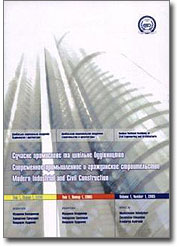Cold Tar-Concrete Mixtures with Adjustable Terms of Structure Formation for the Installation of the Lower Layers of Non-Rigid Road Pavements of Highways
Abstract: In this paper, we develop ideas about the effective structuring of low-viscosity coal tar road tars in the composition of cold tar-concrete mixtures of polycondensations of polyurethane during the interaction of diisocyanates (OCNRNCO) with compounds that contain at least two hydroxyl groups in the molecule, in particular, phthalic anhydride (PDA) distillation bottoms. Using the method of experimental-statistical modeling, the compositions and temperature regimes for the production of complex-modified cold tar concrete were optimized: production temperature 50…55 °C; mass concentration of polyisocyanate 4…6 %; mass concentration of VAT distillation residues of phthalic anhydride 10…15 %. It has been established that modified cold tar concrete goes through three stages of structure formation. For four hours, the mixture retains technological properties. At the second stage, the polyisocyanate reacts with phenol-containing compounds of coal tar and functional groups of distillation bottoms of phthalic anhydride. A three-dimensional grid is formed with nodes from particles of the active dispersed filler ODA and flexible chains from resinous compounds of the coal binder. The third stage is the stabilization of the structure, physical and mechanical properties of the modified tar concrete. Modified cold tar concrete in terms of quality significantly exceeds the indicators of hot tar concrete (GOST 25877).
Keywords: cold tar concrete, coal binder, diisocyanate, structuring, properties of modified tar concrete.
Pages: 73-83.
For citation:
For citation: Bratchun, V. I.; Leonov, N. S.; Demeschkin, V. P. [et al.]. Cold Tar-Concrete Mixtures with Adjustable Terms of Structure Formation for the Installation of the Lower Layers of Non-Rigid Road Pavements of Highways. – Text : electronic. – In: <em>Modern Industrial and Civil Construction</em>. – 2022. – Vol. 18, N 2. – Р. 73-83. – URL: https://donnasa.ru/publish_house/journals/spgs/2022-2/03_bratchun_leonov_demeshkin_protasov_bronevskiy_kuznecov.pdf (date of access: 04.04.2025). – ISSN 1993-3495.

Vol. 18, N 2 (2022)
Journal: Modern Industrial and Civil Construction
Publish house: Donbas National Academy of Civil Engineering and Architecture
Journal: Modern Industrial and Civil Construction
Publish house: Donbas National Academy of Civil Engineering and Architecture
